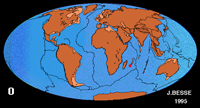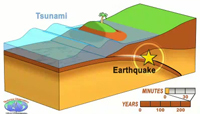
 |
Why Earthquakes and Tsunamis occur in the Sumatra Region |
The surface of the earth is broken into about a dozen major pieces, called tectonic plates, which are constantly moving. The upper portion of these plates consists of the continents and the ocean floors. While the continents and ocean floors seem stationary, they are actually travelling across the globe at about the same rate that fingernails grow, around 5 cm per year (2 inches/year).
 This animation of continental drift shows the motion of the continents over the past 250 million years. [The red spot in the animation is the Reunion Island hot spot, a stationary reference frame of volcanic activity that rises directly from the mantle to the surface and thus does not move with the plates.] Credit: J. Besse
This animation of continental drift shows the motion of the continents over the past 250 million years. [The red spot in the animation is the Reunion Island hot spot, a stationary reference frame of volcanic activity that rises directly from the mantle to the surface and thus does not move with the plates.] Credit: J. Besse
Sumatra is at the boundary between two tectonic plates. The ocean floor southwest of Sumatra is part of the Indian/Australian plate, while Sumatra and the other islands of Indonesia and Thailand are part of the Eurasian plate (see Figure 1). The two plates meet on the ocean floor at the plate boundary (black line in Figure 1), which is about 200 km (125 miles) off the western shore of Sumatra and about 5 km (3 miles) below the ocean surface. 
This plate boundary is called the Sumatran Subduction Trench, and it is where the oceanic Indian/Australian plate is slowly descending beneath (subducting under) the continental Eurasian plate at a rate of about 4.5 cm/year (2 inches/year). The subducting plate eventually sinks back down into the earth's mantle, while further west, at the mid-ocean ridge, new ocean floor is being added to the plate. Rather then sinking straight down, the oceanic plate is taking a shallow dive below the continental plate. In this way, the continental plate is being squeezed sideways at about 1.2 cm per year (1/2 inch/year), as well as getting dragged down at about the same rate. The area over which the two plates overlap is called the Sumatran Subduction Zone, which is shown in Figure 2 as the darker blue regions. 
Figure 2 The Sumatran Subduction Zone, the area where the Indian/Australian plate and the Eurasian plate overlap. The darker the blue, the more shallow the water. Uses CGIAR-CSI SRTM 90M Database. Credit: Mohamed Chlieh, TOFigure 3 shows a schematic of how eathquakes occur in the Sumatran region. As the lower plate grinds past the upper, there are places where the two plates stick together, or lock. These places are called locked fault zones, as shown in Figure 3a. 
Figure 3 a) The oceanic plate is subducting beneath the continental plate. The two plates become stuck, or locked. b) As the lower plate slowly descends, it pulls the upper plate down with it, deforming the land surface above and bulding up stress. The island close to the trench slowly subsides, while further inland the land slowly uplifts. c) When the stress buildup overwhelms the locking friction, the plates suddenly break free from each other and the upper plate slips back. This sudden slip generates an earthquake. The island pops back up, and the land to the right suddenly subsides. This quick displacement of the ocean floor can cause a tsunami. Courtesy James JacksonAs the lower plate continues its descent, it drags the locked area down with it, bending and deforming the upper plate, and thus causing the surface above it to deform. As depicted in Figure 3b, land in the region close to the trench slowly sinks (subsides), while land further away from the boundary slowly rises (uplifts). This process builds up stress. After centuries or even thousands of years, the upper plate will suddenly break free and rebound, slipping by tens of feet (several meters) in a matter of seconds, and generating a giant earthquake. As shown in Figure 3c, this sudden displacement of the land causes islands closest to the trench to uplift in a matter of seconds, and the land further from the boundary to suddenly subside.  This animation of the seismic cycle shows the subduction of the lower plate and consquent deformation of the upper. Credit: TO
This animation of the seismic cycle shows the subduction of the lower plate and consquent deformation of the upper. Credit: TO
The large, sudden upward movement of the sea floor when the locking between two plates is ruptured displaces water. If the displacement is large enough, it can cause great tsunami waves, as happened after the December 2004 Sumatran quake. The quakes of 2005 and 2007 did not cause any major tsunami because the areas of sudden uplift mostly corresponded to areas of islands (Nias, Simeulue, and Mentawai), thus limiting the amount of water that was displaced. Learn more:
|